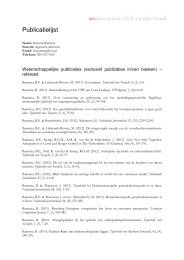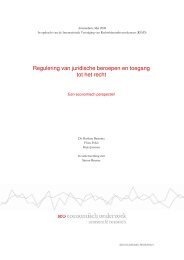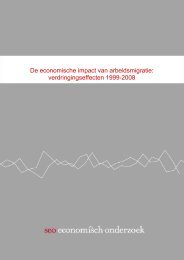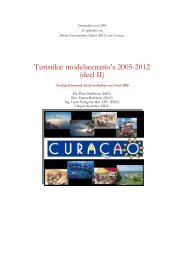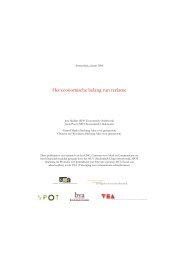Amsterdam, Netherlands - SEO Economisch Onderzoek
Amsterdam, Netherlands - SEO Economisch Onderzoek
Amsterdam, Netherlands - SEO Economisch Onderzoek
You also want an ePaper? Increase the reach of your titles
YUMPU automatically turns print PDFs into web optimized ePapers that Google loves.
The challenge for future social policy in the <strong>Netherlands</strong> is to strike the right balance between theneed for economic competitiveness and social cohesion. Social cohesion may helpcompetitiveness by reducing the opportunity costs of social exclusion, social unrest and the lossof human capital that is generally associated with the weak labor market position ofdisadvantaged groups in society. The intrinsic benefit of social policy is that the fruits of socialservices and benefits may literally aid the feeling of well-being. This latter element surfaced inthe recent literature on the economics of happiness, proclaiming that there is more to economicwell-being than is being measured in GDP. Thus Aiginger (2005) demonstrates that the moreequity-based social policies of the Scandinavian countries produce a population which gives itselfa higher score in terms of happiness and life satisfaction than either the US or other Europeancountries.5.2.1.2 Social exclusion and living conditions in <strong>Amsterdam</strong>In the city of <strong>Amsterdam</strong> 80% of the people is satisfied with his or her living conditions(<strong>Amsterdam</strong> O+S 2008, figure for 2004). This partly reflects the fact that, as was reported inchapter 1, the average income in the <strong>Amsterdam</strong> metropolitan area exceeds the national average.However, just as in other large cities, the city of <strong>Amsterdam</strong> has several neighborhoods with largeconcentrations of socially and economically disadvantaged people. Incomes in theseneighborhoods are circa 10-15% lower than in the rest of the city, while the share of low-incomehouseholds is markedly higher: in 9 of the 15 city boroughs more than 30% of the householdsbelongs to this category (<strong>Amsterdam</strong> O+S, 2008, figure for 2008). The unemployment rates in thedisadvantaged boroughs exceed the <strong>Amsterdam</strong> average by 2 to 2.5%-points, while theunemployment rate among non-Western foreign Dutch nationals exceeds the averageunemployment rate by 5%-points in every borough of the city, pointing to a strongly polarizedregional labor market. Culturally spoken, the disadvantaged <strong>Amsterdam</strong> neighborhoods arecharacterized by a large share of non-Western foreign Dutch nationals, which commonly exceeds50% compared to 34% in the city of <strong>Amsterdam</strong> as a whole (Aalders et al., 2008: 17).In addition, the inhabitants of the major Dutch cities are on average less healthy than in otherparts of the country (Ritsema van Eck et al. 2006, p. 490). The differences in life style are animportant explanation for this difference, but pollution is also a factor. In the <strong>Amsterdam</strong>metropolitan region air pollution emerges as a problem with negative effects on health. Fine dust(PM 10 ) and ozone (O 3 ) are the most import pollutants in <strong>Amsterdam</strong>, causing a wide range ofhealth problems. It is estimated that the health damage due to the concentration of PM 10 in thefour major cities of the <strong>Netherlands</strong> amounts to 10.000 DALYs (Disability Adjusted Life Years)per million inhabitants (Ritsema van Eck et al. 2006, p. 493).5.2.1.3 The contribution of HEIsThe social issues in the metropolitan area are the working field of an extensive line of socialworkers, civil services, mental and health care workers and volunteers. The HEIs contribute totheir work in several ways. In the first place, HEIs contribute to social development by providingservices to the inhabitants of the metropolitan region. Health care is the most important examplein this category. Secondly, HEIs provide education and training of present and future workers inthe social services sector. We mostly ignore this role in the present chapter as it concerns humancapital formation and is therefore discussed in chapter 4. The third role concerns the productionand dissemination of scientific knowledge in the domain of social policies. In fourth place, theHEIs offer physical infrastructure and other facilities to further social development. Finally, therole of students should be considered. Their volunteering activities often enable communityservices with specific social objectives. We shall address these social roles in the subsequentsections respectively.108






